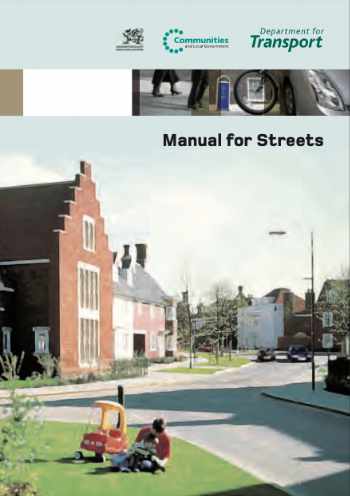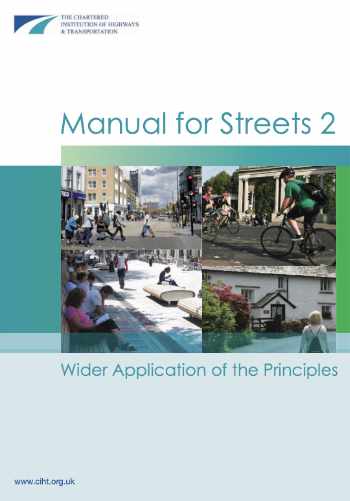Manual for Streets

|

|
Manual for Streets (MfS) is a design guidance document that updated the link between planning policy and residential street design. The manual refocused the place function of residential streets away from purely the function of traffic movement, which had led to places dominated by motor vehicles, putting well-designed residential streets at the heart of sustainable communities.
Contents |
[edit] Manual for Streets (MfS1)
Manual for Streets (MfS) was produced by a team led by consultants WSP, with Llewelyn Davies Yeang (LDY), Phil Jones Associates (PJA) and TRL Limited on behalf of the Department for Transport, and Communities and Local Government and was first published in 2007. It replaced Design Bulletin 32, which was first published in 1977, and its companion guide Places, Streets and Movement, which are now withdrawn in England and Wales. It also complemented Planning Policy Statement 3: Housing and Planning Policy Wales. The MfS did not apply to the trunk road network, which were set out in the Design Manual for Roads and Bridges (DMRB).
[edit] Manual for Streets 2 (MfS2)
Manual for Streets 2 (MfS2) presented a wider application of the principles in initially set-out Manual for Streets (MfS1) and as represented a companion guide that was the product of collaborative working between the Department for Transport and industry and was published In 2010 by The Chartered Institution of Highways and Transportation (CIHT). Whilst MfS1 focussed on lightly-trafficked residential streets, MfS2 investigates in greater detail how and where the key principles can be applied to busier streets and non-trunk roads, thus helping to fill the perceived gap in design guidance between MfS1 and the Design Manual for Roads and Bridges (DMRB).
Combined these documents help demonstrate the benefits of flow from good design and the assignment of higher priority to pedestrians and cyclists. This helps set out an approach to residential streets that recognises their role in creating places that work for all members of the community to make a positive contribution to the quality of life. Between them, MfS1 nad MfS2 give clearer guidance on how to achieve well-designed streets and spaces that serve a community and in a range of different ways, whilst still functioning as roadways.
[edit] Development
In 2020 The Department for Transport commissioned the Chartered Institution of Highways and Transportation (CIHT) to revise and bring together Manual for Streets (MfS1), and Manual for Streets 2 (MfS2) the finalisation and publication of the revised Manual was taken forward by the Department but no date for publication has yet been announced.
To download the first 2007 Manual for Streets publication (MfS1) click here
To download the second 2010 Manual for Streets publication Manual for Streets 2 (MfS2) click here
[edit] About the Chartered Institution of Highways and Transportation (CIHT)
For further information about the Chartered Institution of Highways and Transportation (CIHT) visit their homepage here:
[edit] Related articles on Designing Buildings
- A vision for digital highways.
- Arterial road.
- Cul-de-sac.
- Design standards for road development and improvement schemes.
- Glossary of paving terms.
- Haul road.
- Hazard warning surfaces.
- High street.
- Highways
- Highways agency
- Highways England
- Highways in England and Wales
- Highways Infrastructure Asset Management Plans
- Hounslow highways pathfinder private finance initiative case study
- How to build a road
- Low emission zone for non-road mobile machinery
- Mews.
- National Highways
- Pathway.
- Pavement.
- Protected street.
- Road
- Road construction
- Road drainage
- Road improvement scheme consultation
- Road investment strategy
- Road joints
- Road kerbs
- Road paving
- Road plant
- Road traffic management.
- Road types
- Roadworks.
- Safe pedestrian route.
- Section 171 of the Highways Act
- Section 278 agreement - works to existing highways
- Section 38 agreement - adoption of highways
- Shared space.
- Strategic route.
- Street hierarchy.
- Streetscape.
- Street works.
- The history of the dimensions and design of roads, streets and carriageways.
- Traffic and transport.
- Trunk road.
- Wireless electric highways
Featured articles and news
A change to adoptive architecture
Effects of global weather warming on architectural detailing, material choice and human interaction.
How big is the problem and what can we do to mitigate the effects?
Overheating guidance and tools for building designers
A number of cool guides to help with the heat.
The UK's Modern Industrial Strategy: A 10 year plan
Previous consultation criticism, current key elements and general support with some persisting reservations.
Building Safety Regulator reforms
New roles, new staff and a new fast track service pave the way for a single construction regulator.
Architectural Technologist CPDs and Communications
CIAT CPD… and how you can do it!
Cooling centres and cool spaces
Managing extreme heat in cities by directing the public to places for heat stress relief and water sources.
Winter gardens: A brief history and warm variations
Extending the season with glass in different forms and terms.
Restoring Great Yarmouth's Winter Gardens
Transforming one of the least sustainable constructions imaginable.
Construction Skills Mission Board launch sector drive
Newly formed government and industry collaboration set strategy for recruiting an additional 100,000 construction workers a year.
New Architects Code comes into effect in September 2025
ARB Architects Code of Conduct and Practice available with ongoing consultation regarding guidance.
Welsh Skills Body (Medr) launches ambitious plan
The new skills body brings together funding and regulation of tertiary education and research for the devolved nation.
Paul Gandy FCIOB announced as next CIOB President
Former Tilbury Douglas CEO takes helm.
UK Infrastructure: A 10 Year Strategy. In brief with reactions
With the National Infrastructure and Service Transformation Authority (NISTA).
Ebenezer Howard: inventor of the garden city. Book review.
Airtightness Topic Guide BSRIA TG 27/2025
Explaining the basics of airtightness, what it is, why it's important, when it's required and how it's carried out.





















